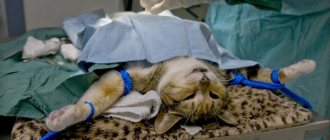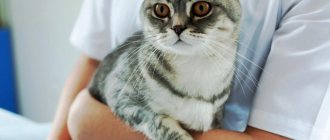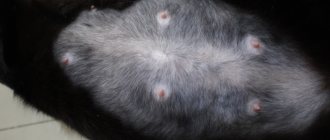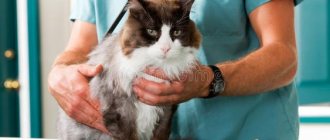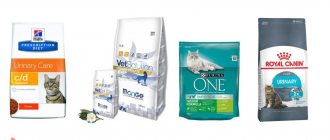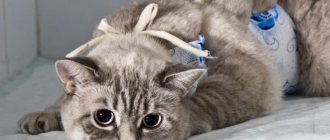Sterilization of cats has long become a standard operation performed in any veterinary clinic. It is believed that the likelihood of developing “side effects” is extremely low, but... a lot depends on the owner. If you do not process the seam after sterilization, or do it incorrectly, it will end sadly.
General recommendations
The owner needs to remember a number of important nuances. Analgesics must be used in the first three days before treatment. At this time, the cat will painfully perceive any mechanical impact on the seam. The animal may resist, scratch, and in the most severe cases, painful shock is possible.
Under no circumstances use paracetamol or other medicines from your home medicine cabinet for these purposes! “Human” anesthetics are in many cases deadly for cats.
We strongly do not recommend removing the surgical collar (if any) from the cat during treatment! Without it, the cat may bite the owner, especially in the first days after surgery, when the suture can cause the animal a lot of discomfort.
The first treatment should be carried out on the second day after surgery. There's no point in doing it earlier!
Finally, the frequency of processing. It is believed that this should be done no more than twice a day. If the seam heals well and does not ooze ichor, you can disinfect it every two days (remember to consult a veterinarian first).
Hospital: to be or not to be?
To avoid unnecessary problems, some owners leave the animal in a hospital - of course, this will cost more, but the cat will be under the supervision of specialists, there is no need to take the pet home (especially in the cold season), the issue of independent care and responsibility for compliance are eliminated. all the rules. This technique also has disadvantages: firstly, you must be confident in the reputation of the veterinarian and, in fact, the clinic; secondly, for a cat, a change of environment, and even after surgery, is constant stress. Thirdly, the animal may be offended, considering this as inattention on your part.
Rules for processing postoperative sutures
How to perform this procedure correctly?
First of all, there is no need to rush. Secondly, you must strictly follow the instructions below:
- First, you need to moisten a cotton-gauze swab or just a gauze swab with an antiseptic composition, and then, without making sudden movements, wipe the seam along the edge, removing dried ichor and other contaminants.
- It is not advisable to wipe the surface of the seam; it is recommended to do this only if it is very dirty. It is better to apply antiseptic ointments and similar dosage forms directly to the seam.
- All skin folds in the suture area must be thoroughly smoothed and washed with an antiseptic. Dirt accumulates in them, and pathogenic microflora actively develops there.
- In addition, veterinarians advise treating the seam while the cat is standing. This approach reduces the likelihood that part of the antiseptic composition will get deep into the wound canal.
Mistakes of inexperienced owners
Here is a list of critical mistakes that inexperienced breeders most often make:
- “Filling” the seams with an alcohol tincture of iodine or brilliant green. First of all, it hurts. Secondly, such a concentration of antiseptic compounds does not lead to anything good. More precisely, they simply burn the tissue, which is why a chemical burn also develops right at the postoperative suture, in addition to other “joys”. Accordingly, the regeneration time increases significantly.
- Owners who believe that the seam (provided it looks good) does not need to be processed at all are also mistaken. Like, “it will heal like that.” We must not forget that the environment is rarely sterile, and therefore the wound canal can be contaminated with pathogenic or conditionally pathogenic microflora at any time. This phenomenon will certainly lead to the development of purulent inflammation.
- Some breeders vigorously rub the seam during processing, which is also unacceptable. Rough processing can, firstly, introduce an infection into the seam, and secondly, such actions slow down the regeneration process.
- You cannot thickly coat the seams with ointments, you cannot “tightly” cover it with tight bandages. There must be air access to the wound channel! Otherwise, anaerobic infections may develop, which are fatal to the health of the animal (and often lead to death).
How to treat the seam?
The following compositions can be used to treat a postoperative wound and the tissue around it:
- Miramistin.
- You can treat the seam with chlorhexidine. It is even preferable to the previous option, since the composition has a better antiseptic effect.
- The skin around the seam can be treated with regular alcohol tincture of iodine and brilliant green. The main thing is not to pour these compounds into the wound channel!
- The surface of the seam can and should be treated with levomekol. This is an ointment with a pronounced bactericidal effect. In addition, the composition of dense consistency prevents debris and microflora from entering the wound channel.
Removing stitches for a cat after sterilization
If the healing process proceeds normally, the sutures should be removed after sterilization of the cat 7-10 days after the manipulation. This applies to surgical intervention performed by dissecting tissue along the white line of the abdomen.
If sterilization was carried out through a side incision, then cosmetic sutures are applied that do not need to be removed. Typically, after a cat is spayed, the suture heals within 10 days.
Complete tissue restoration depends on the type of surgery and suturing method. The healing process is always accompanied by itching in the pet, so it is necessary to take care of a special protective blanket that will help prevent licking or infection of the wound surface.
After time, the owner of the animal, with normal healing of the postoperative suture, can independently remove the sutures.
It is important to remember that only the suture material that is visible on the surface of the skin must be removed. It is strictly prohibited to get into the wound and remove internal stitches from a cat after sterilization. It is better, of course, to go to a veterinary clinic, since they will be able to properly fix the animal, assess the state of healing of the suture and remove the suture material.
How many days to process the seam
Of course, much in this case depends on the specific animal, the success of the operation, the type of sterilization and other factors. Given all this, we recommend that you carefully consult with the veterinarian who performed the operation. He can give a lot of valuable advice.
- The older the animal, the longer it takes to look after its stitch. So, in cats aged seven years and older, the seam completely heals in about two weeks. And all this time, accordingly, the owner needs to regularly carry out treatment. Accordingly, in young cats, post-operative wounds heal much faster, which reduces the duration of treatment.
- It takes the longest to process the seam left after cavity sterilization. At least five days, often this period is longer. The wounds left after laparoscopic sterilization cause the least problems. As a rule, already on the third day after the operation they are completely overgrown, which is why the need for treatment also disappears.
Suture in cats after sterilization
As mentioned earlier, where the suture will be located after spaying a cat depends on the method and type of surgery to remove reproductive organs in females.
An important point is proper treatment and care of the suture after sterilization. Until the veterinarian allows the sutures to be removed, it is necessary to carry out daily treatment with special antiseptic agents that do not contain alcohol (to avoid skin burns).
The suture heals after sterilization in a cat, depending on the incision and the method of operation performed. In the vast majority of cases, sutures are removed within 7-10 days. Sutures not removed in time begin to grow into the skin on the 12th day.
The seam after sterilization of the cat should look neat, without severe swelling and strong changes in the color of the skin. Stitches are applied during sterilization in two main ways:
- paperclip;
- continuous.
The first type of seam looks like several threads tied into knots at equal intervals. A continuous suture has a beginning and runs through the entire wound, being fixed at the other end.
In veterinary practice, the staple suture is increasingly used. Since when exudate occurs under the skin in the area where suture material is applied, several threads can be removed without unraveling the remaining edges of the wound, which cannot be done with a continuous suture.
When carrying out sterilization using a technique through a side incision, the seam will not be large (no more than 1 cm) and will be located on the side and not in the middle of the abdomen. A suture on the side does not necessarily require wearing a postoperative bandage and caring for it is much easier.
Particular attention should be paid to absorbable sutures, as they are gaining great popularity among veterinarians.
This is due to the fact that when applying a cosmetic suture after sterilizing a cat, careful postoperative care of the sutures is not required.
The risk of postoperative complications is minimized. In addition, self-dissolving sutures in a cat after sterilization are much more convenient for both the owner and the pet itself. There is no need to urgently go to the veterinary clinic, exposing the cat to further stress, to remove post-operative sutures.
The main advantages of an internal suture compared to a cutaneous suture are:
- rapid healing of the wound surface, which is associated with the preservation of trophism of tissue structures;
- the seam does not compress the outer layers of the skin, so damage is minimal;
- absence of postoperative blankets;
- lack of suture removal procedure;
- processing the seam after sterilizing a cat does not require increased attention or special skills;
- preventing the possibility of the seam coming apart as a result of licking by the pet;
- absence of a mark on the skin 2.5 months after the procedure to remove the reproductive organs of a cat.
It is worth remembering that applying a cosmetic internal suture is not always possible for a number of medical reasons. That is why external seams are more often used, requiring further proper care.
The veterinarian who performed the manipulation should tell you how and what to use to treat the cat’s sutures after sterilization. After all, only the surgeon who performed the operation will be able to accurately indicate possible defects and complications during the recovery period.
Before starting to treat the seam, you must give your pet an anesthetic and wait at least 60 minutes. After anesthesia, it is necessary to clean the wound surface from villi, dried blood or ichor using a cotton pad previously soaked in a chlorhexidine solution. It is important to remember that the treatment of the seam itself should be done no earlier than 2 days after sterilization. After cleaning, an antibiotic ointment is applied to the wound, lubricating all folds (this is necessary to prevent pathogenic bacterial microflora from entering and further multiplying into the wound).
If the animal's operation was performed using a side incision, then caring for the wound is even easier. The side seam is treated with special means - Aluminum spray or Chemi spray. Treatment is carried out once a day or once every 2-3 days until the wound is completely healed.
What to do if the cat does not allow the seam to be processed?
It happens that the pet (especially in the first day after sterilization) is not allowed into the hands and resists when the owner tries to treat the seam. At this time, the animal still experiences unpleasant sensations, which explain the outbursts of aggression.
And if the cat does not allow the seam to be processed, you need to do the following:
- If the animal is strong, it is advisable to use mild sedatives and painkillers.
- A surgical collar is required. It will prevent the animal from scratching the owner, as well as from tearing the interfering seam later.
- In the most severe cases, you have to “swaddle” the cat using a sheet or pillowcase, and then inspect and treat the seam on its stomach.
In addition, it won’t hurt to talk to your pet, pet it more often and calm it down. If the cat gets used to the daily treatment of seams, then it will be much calmer about it. When processing, you do not need to make sudden movements; you should not press too hard on the tampon.
Transportation after surgery
Immediately after sterilization, the cat can be taken home. At this moment, she is still under anesthesia, as a result of which the body experiences hypothermia. Therefore, using public transport for transportation is not recommended. It is best to call a taxi or use your own car.
You should not carry your cat in your arms. On the way home, she may begin to recover from the anesthesia. Her condition at this moment will be very inadequate, and perhaps even aggressive. When you try to break out, its outer and inner seams may simply separate.
Transporting a sterilized cat with a stitch must be carried out in a carrier. Before doing this, it is recommended to wrap it in a blanket or a warm blanket. This will help prevent hypothermia in a weakened cat's body. The use of additional heat sources is not recommended. Overheating can cause internal bleeding. The animal in the carrier should lie on its side. In case of vomiting in this position, the vomit will come out freely.

